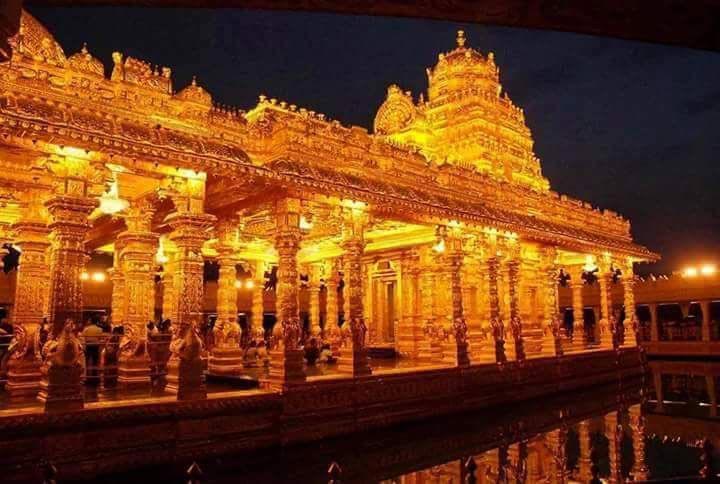In the heart of the southern Indian state of Andhra Pradesh lies a sacred abode that resonates with spirituality and ancient mystique – the Kalahasti Sivan Temple. Nestled in the town of Srikalahasti, this venerable temple is dedicated to Lord Shiva, one of the principal deities in Hinduism. With its rich history, architectural splendor, and religious significance, the Kalahasti Sivan Temple stands as a testimony to the enduring cultural and spiritual heritage of India.
Historical Perspective:
The roots of the Kalahasti Sivan Temple can be traced back to the Chola dynasty, with its construction believed to have begun in the 5th century. Over the centuries, various rulers and dynasties have contributed to its expansion and renovation, resulting in the magnificent structure we see today. The temple’s architecture bears the hallmarks of Dravidian style, characterized by towering gopurams (ornate entrance towers), intricate carvings, and sprawling courtyards.
Legend of the Temple:
The lore surrounding the Kalahasti Sivan Temple is as captivating as its architecture. One of the most prominent legends associated with the temple is the story of Kannappa, a staunch devotee of Lord Shiva. According to the legend, Kannappa was a tribal hunter who, despite his humble background, displayed unwavering devotion to Lord Shiva. The tale of Kannappa’s devotion, including his act of plucking out his own eyes to replace the damaged eyes of the Shiva Linga, is a testament to the intense spiritual fervor that the temple has inspired throughout the ages.
Unique Features:
The Kalahasti Sivan Temple is renowned for its unique architectural and artistic features. The temple’s main sanctum houses the Shiva Linga, representing the cosmic energy and the divine union of Lord Shiva and Goddess Parvati. The intricately carved pillars and walls depict scenes from Hindu mythology, showcasing the skill and craftsmanship of ancient artisans.
One of the distinguishing features of the temple is its association with the Pancha Bhoota Sthalas, which represent the five elements of nature. Kalahasti is particularly significant as the temple dedicated to Vayu (wind), and the presiding deity, Lord Kalahasteeswara, is believed to embody the element of air. Pilgrims visit the temple to seek the blessings of Lord Kalahasteeswara for relief from afflictions related to air elements, such as respiratory ailments.
Rahu-Ketu Dosha Nivarana:
The Kalahasti Sivan Temple is also famous for its role in mitigating the adverse effects of Rahu-Ketu dosha, a planetary alignment in Hindu astrology associated with malefic influences. Devotees believe that a pilgrimage to this temple can alleviate the negative impacts of Rahu-Ketu dosha and bring about positive changes in their lives. The unique ritual of ‘Rahu-Ketu Sarpa Dosha Nivarana Puja’ performed at the temple is sought after by individuals facing astrological challenges.
The annual Maha Shivaratri festival is a grand celebration at the Kalahasti Sivan Temple, drawing thousands of devotees who converge to witness the divine energy and seek the blessings of Lord Shiva. The temple complex comes alive with fervent prayers, cultural performances, and a spiritual aura that envelops the entire town.
Spiritual Significance:
For devout Hindus, the Kalahasti Sivan Temple holds immense spiritual significance. The temple is considered one of the Pancha Bhoota Sthalas, symbolizing the primordial elements of nature. The belief in the sanctity of the temple and its divine connection with Lord Shiva draws pilgrims from far and wide, seeking solace, blessings, and spiritual enlightenment.
The temple’s location, nestled between the holy rivers of Swarnamukhi and Bharathappuzha, adds to its spiritual allure. The serene surroundings create an atmosphere conducive to introspection and meditation, allowing visitors to connect with the divine in a profound way.
Architectural Grandeur:
As visitors approach the Kalahasti Sivan Temple, they are greeted by the imposing gopurams adorned with intricate sculptures and carvings that narrate stories from Hindu mythology. The main sanctum, or ‘garbhagriha,’ is a marvel of Dravidian architecture, with its ornate pillars and detailed craftsmanship. The temple’s complex layout includes various mandapams, or halls, each with its unique architectural charm.
The temple’s Raja Gopuram, standing tall at the entrance, is a visual spectacle, showcasing the skill and artistry of the architects of yesteryears. The meticulously sculpted figures and the towering structure create a sense of awe, inviting pilgrims and tourists alike to explore the spiritual and artistic treasures within.
Preservation Efforts:
Over the centuries, the Kalahasti Sivan Temple has undergone several renovations and preservation efforts to maintain its architectural splendor and cultural heritage. The Archaeological Survey of India (ASI) and local authorities have worked tirelessly to protect and restore the temple, ensuring that future generations can continue to experience its divine ambiance and historical significance.
Visitors to the temple are often struck by the meticulous conservation work, which aims to strike a balance between preserving the ancient structure and making it accessible to the modern world. The conservation efforts also include documentation of the temple’s history and architectural details, providing invaluable insights into India’s cultural tapestry.
Conclusion:
The Kalahasti Sivan Temple stands not only as a testament to the architectural prowess of ancient India but also as a living testament to the enduring spiritual legacy that continues to captivate hearts and minds. From its rich history and captivating legends to its unique rituals and architectural grandeur, every aspect of the temple contributes to its mystique and allure.
As pilgrims and tourists embark on a journey to the Kalahasti Sivan Temple, they are not merely visitors but participants in a timeless tradition that transcends the boundaries of time and space. The temple’s sacred vibrations, coupled with the surrounding natural beauty, create an atmosphere that is both enchanting and transformative, inviting all who enter to experience the divine presence that has graced this sacred space for centuries.



